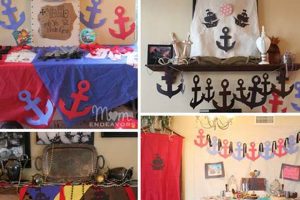Creating personalized aquatic environments involves constructing ornamental elements for fish tanks using self-sourced or repurposed materials. For example, individuals might fashion caves from slate or craft plant holders from coconut shells to enhance the aesthetic and functional aspects of their home aquariums.
The practice of custom-building features for underwater habitats offers significant advantages, including cost savings and the ability to tailor the environment precisely to the needs and preferences of its inhabitants. Historically, this approach has allowed hobbyists to express their creativity while providing enriched surroundings for aquatic life, fostering a sense of stewardship and engagement.
The subsequent sections will delve into specific materials suitable for safe crafting, explore techniques for designing functional and visually appealing decorations, and address essential considerations for maintaining the integrity of the aquatic ecosystem while integrating handmade components.
Crafting Personalized Aquatic Environments
Constructing ornamentation for fish tanks necessitates adherence to specific guidelines to ensure the well-being of the aquatic inhabitants and the stability of the ecosystem.
Tip 1: Material Selection: Opt for materials that are inert and non-toxic within an aquatic environment. Untreated natural slate, thoroughly cleaned driftwood sourced from non-resinous trees, and aquarium-safe silicone are viable choices. Avoid metals that corrode, painted ceramics, and plastics not explicitly designated for aquarium use.
Tip 2: Thorough Cleaning and Preparation: Before introducing any handcrafted item, meticulous cleaning is paramount. Boil rocks and driftwood to eliminate potential pathogens and tannins. Scrub all surfaces to remove loose particles or contaminants. Cure silicone-based adhesives fully before submersion.
Tip 3: Structural Integrity and Stability: Ensure that constructed elements are structurally sound and will not collapse, potentially harming aquatic life. Securely bond components using appropriate adhesives and consider the weight and displacement of objects within the water column.
Tip 4: Avoid Sharp Edges and Confined Spaces: Design decorations to minimize sharp edges that could injure fish. Similarly, avoid creating enclosed spaces with inadequate access, as fish may become trapped and perish.
Tip 5: Consider Species-Specific Needs: Tailor the crafting approach to the specific requirements of the inhabitants. For example, provide ample hiding places for shy species or create spawning sites suitable for breeding behaviors.
Tip 6: Gradual Integration and Observation: Introduce new elements to the tank gradually, monitoring water parameters and the behavior of the fish. Observe for any signs of stress or adverse reactions to the introduced materials.
Tip 7: Regular Maintenance and Inspection: Regularly inspect crafted items for deterioration or the accumulation of algae or detritus. Clean decorations periodically to maintain water quality and prevent the buildup of harmful substances.
Adhering to these principles enables hobbyists to create aesthetically pleasing and ecologically sound aquatic environments, enhancing the well-being of their fish and invertebrates.
The subsequent section will explore advanced techniques for constructing complex aquatic landscapes and address troubleshooting common challenges encountered in the process.
1. Material Safety
The selection of appropriate materials constitutes the foundational element in creating safe and sustainable decorations for aquatic environments. The chemical and physical properties of submerged items directly impact water quality and the health of inhabitants. Consequently, informed material choices are paramount to the success of any self-constructed aquarium embellishment.
- Inertness and Chemical Stability
Materials introduced into an aquarium must exhibit inertness, meaning they do not leach harmful substances into the water column. Items such as untreated metals, certain plastics, and improperly cured paints can release toxins, altering pH levels and endangering aquatic life. The use of aquarium-safe silicone and carefully chosen natural materials mitigates these risks.
- Porosity and Surface Texture
The porosity and surface texture of decorations influence bacterial colonization and the accumulation of detritus. Highly porous materials provide extensive surface area for beneficial bacteria, contributing to biological filtration. However, excessive porosity can also trap debris, leading to anaerobic conditions and the release of harmful compounds. Smooth, easily cleanable surfaces minimize this issue.
- Physical Durability and Resistance to Degradation
Decorations must withstand prolonged submersion without degrading or disintegrating. Materials prone to decay or erosion can compromise water quality and create hazardous conditions for fish and invertebrates. Natural materials, such as certain types of rock and driftwood, should be thoroughly cured and inspected for stability prior to introduction.
- Absence of Sharp Edges and Entrapment Hazards
The physical design of decorations must prioritize the safety of aquatic inhabitants. Sharp edges and small crevices can cause injuries or trap smaller fish and invertebrates. Smooth, rounded designs minimize these risks, ensuring a safer and more comfortable environment for the aquarium’s occupants.
The aforementioned facets of material safety directly relate to the overall health and stability of the aquarium ecosystem. By adhering to established guidelines and prioritizing non-toxic, durable, and structurally sound materials, individuals can create personalized aquarium features that enhance both the aesthetic appeal and biological integrity of their aquatic environments.
2. Design Functionality
Design functionality, in the context of creating ornamental elements for fish tanks, refers to the degree to which crafted items serve a practical purpose beyond mere aesthetic enhancement. Effective design considerations address the biological needs of the aquatic environment and its inhabitants.
- Provision of Shelter and Territory
Crafted caves, rock formations, and plant structures offer refuge and establish territorial boundaries, essential for reducing stress and aggression among fish. For example, constructing multiple small caves with varying entrances allows different species or individuals to establish their own spaces, minimizing conflict and promoting a more stable social hierarchy within the tank.
- Support for Biological Filtration
Design can incorporate elements that enhance biological filtration. Creating structures with high surface area, such as porous rock or intricately arranged driftwood, provides ample space for beneficial bacteria to colonize. These bacteria play a crucial role in converting harmful ammonia and nitrite into less toxic nitrate, maintaining water quality.
- Facilitation of Feeding and Spawning Behaviors
Customized structures can facilitate specific feeding or spawning behaviors. For instance, creating shallow depressions within rock formations can serve as suitable spawning sites for certain fish species. Similarly, strategically placing plants or creating overhangs can provide shaded areas where fish can ambush prey or seek refuge during feeding.
- Integration with Plant Life
Crafted structures can seamlessly integrate with aquatic plants, providing support, anchoring points, and protection. Creating planters from inert materials allows for the controlled placement and growth of plants, enhancing the aesthetic appeal of the tank while also contributing to oxygenation and nutrient uptake.
By prioritizing functional design elements, DIY aquarium decor transcends simple ornamentation and becomes an integral component of a healthy and thriving aquatic ecosystem. The incorporation of shelter, filtration support, behavioral facilitation, and plant integration exemplifies the symbiotic relationship between aesthetics and functionality in aquarium design.
3. Structural Integrity
Structural integrity, within the context of self-constructed aquatic ornaments, denotes the capacity of created elements to withstand the forces exerted by the aquatic environment over extended periods. Maintaining this integrity is crucial for preventing hazards to aquatic life and preserving the aesthetic quality of the aquarium.
- Material Load-Bearing Capacity
The materials used in construction must possess sufficient load-bearing capacity to support their own weight and any additional stress from water pressure or the weight of substrate and decorations placed upon them. For example, constructing a large rock formation requires utilizing materials, such as dense slate or appropriately reinforced concrete, that will not crumble or collapse under pressure, ensuring the stability of the structure and preventing potential injury to inhabitants.
- Adhesive Bond Strength and Durability
Adhesives used to join components must form a durable and waterproof bond capable of withstanding continuous submersion and temperature fluctuations. Aquarium-safe silicone, specifically formulated for aquatic applications, provides a resilient bond between various materials. Inadequate adhesive strength can lead to detachment of components, resulting in unstable structures and potential hazards within the aquarium.
- Resistance to Erosion and Degradation
Materials should resist erosion and degradation caused by prolonged exposure to water, chemical fluctuations, and biological activity. Certain types of rock or improperly treated wood can leach minerals or decompose, compromising water quality and weakening the structure. Selecting materials known for their resistance to degradation and properly sealing or treating them helps ensure long-term structural integrity.
- Joint Stability and Reinforcement Techniques
The design and construction of joints between components significantly impact overall stability. Weak or poorly designed joints are prone to failure, leading to structural instability. Employing reinforcement techniques, such as interlocking designs or the use of hidden supports, enhances joint strength and distributes stress more evenly throughout the structure.
The interconnectedness of these facets underscores the importance of careful planning and execution in creating structurally sound elements for custom aquatic environments. Addressing material load-bearing capacity, adhesive bond strength, resistance to degradation, and joint stability collectively contributes to the creation of long-lasting, safe, and visually appealing additions to the underwater landscape.
4. Water Chemistry
The interaction between water chemistry and self-made fish tank ornaments represents a critical aspect of aquatic ecosystem management. Submerged components can directly influence parameters such as pH, hardness, and the concentration of various chemical compounds. Improperly selected or prepared additions can introduce undesirable substances, disrupting the delicate balance necessary for aquatic life. For example, untreated limestone introduced as decorative rock will elevate pH and water hardness, potentially harming fish species adapted to soft, acidic conditions. Similarly, certain woods, if not properly cured, release tannins, lowering pH and discoloring the water. Therefore, informed selection and preparation of aquarium decorations are essential for maintaining stable water conditions.
Understanding the effects of different materials on water chemistry allows for proactive management of the aquarium environment. Regular water testing and adjustments based on the composition of decor are crucial. Consider a situation where a crafted cave structure, assembled with aquarium-safe silicone, nonetheless causes localized stagnation and anaerobic conditions within its recesses. This can lead to the production of hydrogen sulfide, a toxic gas. Addressing such a problem requires structural modification to improve water flow and prevent the accumulation of waste. Furthermore, buffering capacity, the water’s ability to resist pH changes, must be considered. The presence of decorations with a high surface area for biological filtration can enhance this capacity, contributing to a more stable chemical environment.
In summary, the selection and integration of self-constructed ornamental elements require careful consideration of their potential impact on water chemistry. Continuous monitoring and proactive adjustments, informed by an understanding of material properties and their effects on aquatic parameters, are essential for ensuring the health and stability of the aquarium ecosystem. Ignoring this relationship can lead to significant challenges in maintaining optimal conditions and sustaining aquatic life.
5. Aesthetic Harmony
Achieving aesthetic harmony in an aquatic environment created through self-constructed elements requires careful consideration of visual balance, color palettes, and the spatial arrangement of components. The presence or absence of such harmony directly influences the perceived quality and naturalism of the aquarium. For example, an assemblage of brightly colored, artificial decorations lacking a cohesive theme often creates a jarring and unnatural aesthetic, potentially detracting from the perceived well-being of the aquatic inhabitants. Conversely, a carefully planned aquascape incorporating naturalistic elements like driftwood, rocks, and live plants, arranged according to established principles of design, can result in a visually appealing and biophilic environment.
The selection of materials plays a crucial role in fostering aesthetic unity. The use of a consistent substrate, such as fine gravel or sand, across the aquarium floor establishes a foundational element of harmony. Similarly, the incorporation of rocks and driftwood sourced from a single origin often imparts a sense of natural continuity. The arrangement of these elements, adhering to principles such as the golden ratio or the rule of thirds, can further enhance the visual appeal of the aquascape. Furthermore, careful consideration of plant selection, choosing species that complement the overall color scheme and growth patterns, contributes to a cohesive and balanced aesthetic.
Ultimately, the pursuit of aesthetic harmony within the context of DIY aquarium dcor necessitates a holistic approach, integrating design principles with a thorough understanding of aquatic ecosystems. While personal preferences undoubtedly influence the final outcome, a conscious effort to create a visually unified and naturalistic environment enhances the aesthetic enjoyment of the aquarium and potentially benefits the well-being of its inhabitants. Challenges arise in balancing personal artistic expression with the biological needs of the aquarium, but the thoughtful integration of design and functionality yields aesthetically pleasing and ecologically sound aquatic environments.
Frequently Asked Questions
The following addresses common inquiries and misconceptions concerning the creation and implementation of self-constructed ornamental elements in aquatic environments.
Question 1: What types of materials are generally considered safe for use in creating items for fish tanks?
Inert materials that do not leach harmful substances into the water are suitable. Examples include thoroughly cleaned and untreated natural slate, certain types of well-seasoned driftwood (avoiding resinous woods), aquarium-safe silicone, and specific plastics explicitly designated for aquarium use.
Question 2: How should materials be prepared before introducing them into the aquarium to minimize risks?
Rigorous cleaning is essential. Boiling rocks and driftwood helps eliminate potential pathogens and tannins. All surfaces should be scrubbed to remove loose particles. Silicone-based adhesives require complete curing prior to submersion to prevent the release of toxic compounds.
Question 3: What factors should be considered when designing structures to ensure the safety of aquatic life?
Designs should minimize sharp edges and confined spaces where fish may become trapped or injured. Structural stability is paramount to prevent collapse. It is advisable to create elements that provide shelter and mimic natural habitats.
Question 4: Can self-constructed components affect water chemistry, and if so, how can such effects be mitigated?
Certain materials can alter water parameters. Limestone, for example, elevates pH and hardness. Monitor water chemistry regularly after introducing crafted items. Adjustments to water changes or the addition of buffering agents may be necessary to maintain stability.
Question 5: Is it possible to incorporate live plants into elements, and what precautions should be taken?
Integration with live plants is feasible and often beneficial. Use inert planters and ensure adequate water circulation around the plants. Select plant species compatible with the lighting and water conditions within the aquarium.
Question 6: How often should self-constructed features be inspected and maintained?
Regular inspection is advised. Look for signs of deterioration, algae buildup, or the accumulation of detritus. Periodic cleaning with aquarium-safe methods is necessary to maintain water quality and prevent the growth of harmful organisms.
Prioritizing safety, material compatibility, and structural integrity are essential for successful DIY aquarium decor. Continual monitoring and proactive adjustments are critical for sustaining a healthy aquatic environment.
The concluding section will present case studies and examples illustrating the practical application of these principles.
DIY Aquarium Decor
This exploration has traversed the critical aspects of “diy aquarium decor”, emphasizing material safety, design functionality, structural integrity, water chemistry considerations, and aesthetic harmony. These elements, when thoughtfully integrated, yield aquatic environments that are both visually engaging and biologically sound. The significance of adhering to established guidelines cannot be overstated; neglecting these principles compromises the health and stability of the contained ecosystem.
The responsible creation of personalized aquatic environments demands informed decision-making and diligent maintenance. It is incumbent upon the hobbyist to prioritize the well-being of aquatic life above purely aesthetic pursuits. Continued research and adherence to best practices will further refine the art of “diy aquarium decor”, promoting sustainable and enriching aquatic ecosystems for future enjoyment and study.







